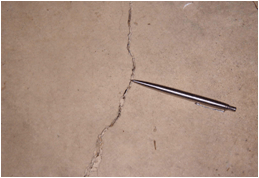Slab foundations can be found under many homes. Typically, this type of structural base sits over soil or gravel and helps to distribute the weight of the building above it. The thickness of slab foundations vary depending on the type of structure they hold. If the soil underneath the slab is not prepared properly, cracks can appear in the slab. The term “cracked slab” can be used to describe a variety of slab foundation problems.
Slab Damage Severity
Slab crack repair varies depending on the type of crack, the cause of the crack and its severity. A small hairline crack running through a floor tile may not always be cause for alarm — in areas where drought conditions have been suffered, tile with a hairline crack may be the result of soil settlement. A slab crack that continues up into the home’s wall is a cause for concern and should be examined by a qualified repair specialist.
A cracked slab also may be the result of shrinkage in the concrete or building materials, foundation settling or slab foundation movement caused by frost heaves and/or expansive soil. In general, shrinkage cracks do not compromise the building’s structural integrity, but they can lead to water leaks and crawl space moisture. Cracked slabs from soil settlement also can lead to unwanted moisture.
Expansive Soils

Cracked slabs due to expansive soils or other conditions need to be inspected by a foundation repair specialist. When left unchecked, foundation problems can cause serious structural damage to the home. Contact a repair specialist to prevent further damage from occurring.
